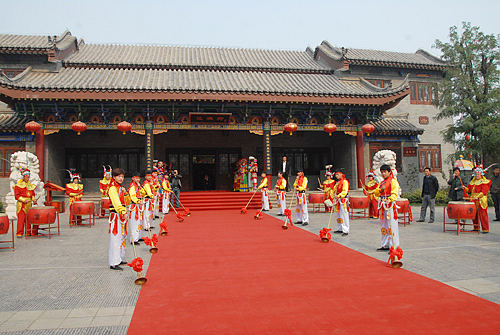|
 |
|
WELCOME CEREMONY: Luanxian County held a traditional ceremony to welcome tourists on October 27 (BAI SHI) |
The first Luanhe River Cultural Festival kicked off in Luanxian County, nearby Tangshan in Hebei Province on October 12, to commemorate the city's history, which is largely unknown to people today.
Invited by the local government, historians, cultural scholars and artists from across the country assembled in Luanxian for the festival and discussed how to develop local cultural heritage and tourism resources.
The history of Luanxian reaches back to about 3,000 years ago. The ancient Chinese established Luanzhou (the former name of Luanxian) and thrived there because of the Luanhe River, which starts in west Hebei Province and flows into the Bohai Sea. Therefore, people regard Luanhe River as the mother river of their local civilization.
As a land-water transport hub in China, Luanxian attracted tens of thousands of merchants to do business there and enjoyed a reign of prosperity for nearly 1,000 years. Also, both farming and nomadic cultures converged in this area along the Luanhe River, which contributed to a brilliant multi-cultural environment in the county.
With abundant mineral resources, Luanxian has been an economic and transport hub in east Hebei Province since the late 19th century. But the county has decided to reclaim its former glory through regeneration. Instead of relying on its industrial power, the county will explore its cultural heritage and develop leisure tourism featuring local traditions.
Luanxian has achieved rapid industrial growth since 1978. In recent years, the county has established six economic parks and several industry chains, such as metal refining, equipment manufacturing, agriculture and services.
Sijiaying iron ore mine—the second largest iron ore mine of Asia located 10 km south of the county, was put into production in 2008, and became an important pillar of the local economy. By the end of 2010, the GDP of the county had reached 26.2 billion yuan ($4.12 billion), which ranked 17th at the county level in Hebei Province.
However, the Luanxian people won't rely only on nonrenewable resources for future development. The heavy industry has polluted the environment. Locals realize that there should be a balance between economic growth and environmental protection. Luanxian also has huge potential to develop and promote its immense traditional cultural treasures.
"We have to develop with both feet—one is the established industrial sector, and the other is culture and tourism, because economic growth cannot be sustained by exploiting ore mines forever," Lu said. The booming cultural sector and tourism sector can boost local urbanization, raise the image of the county and improve the quality of the people's livelihoods," said Lu.
| 